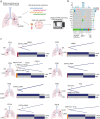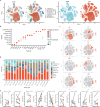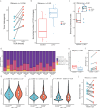Genomic and immune heterogeneity of multiple synchronous lung adenocarcinoma at different developmental stages
- PMID: 39256403
- PMCID: PMC11387495
- DOI: 10.1038/s41467-024-52139-2
Genomic and immune heterogeneity of multiple synchronous lung adenocarcinoma at different developmental stages
Abstract
Multiple synchronous lung cancers (MSLCs) constitute a unique subtype of lung cancer. To explore the genomic and immune heterogeneity across different pathological stages of MSLCs, we analyse 16 MSLCs from 8 patients using single-cell RNA-seq, single-cell TCR sequencing, and bulk whole-exome sequencing. Our investigation indicates clonally independent tumours with convergent evolution driven by shared driver mutations. However, tumours from the same individual exhibit few shared mutations, indicating independent origins. During the transition from pre-invasive to invasive adenocarcinoma, we observe a shift in T cell phenotypes characterized by increased Treg cells and exhausted CD8+ T cells, accompanied by diminished cytotoxicity. Additionally, invasive adenocarcinomas exhibit greater neoantigen abundance and a more diverse TCR repertoire, indicating heightened heterogeneity. In summary, despite having a common genetic background and environmental exposure, our study emphasizes the individuality of MSLCs at different stages, highlighting their unique genomic and immune characteristics.
© 2024. The Author(s).
Conflict of interest statement
The authors declare the following competing interests: K.L. has the following disclosures (all outside of the submitted work): patent on indel burden and CPI response pending, patent on ctDNA minimal residual disease calling methods; speaker fees from Roche tissue diagnostics and Ellipses pharma; research funding from CRUK TDL/Ono/LifeArc alliance and Genesis Therapeutics; and consulting roles with Monopteros Therapeutics, Kynos Therapeutics and Tempus Labs, Inc. M.A. is supported by the City of London Centre Clinical Academic Training Programme (Year 3, SEBSTF-2021\100007). All the other authors declare no competing interests.
Figures






References
Publication types
MeSH terms
Substances
Grants and funding
LinkOut - more resources
Full Text Sources
Medical
Research Materials

